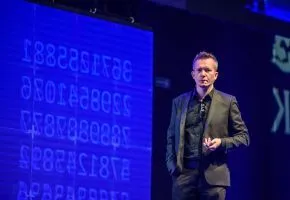 25.09.2018
25.09.2018
infoShare '18 flashback: Visual Search, Particle Collisions and Content Popularity Prediction: Hands-on Success Stories of Computer Vision
Although still a challenge, computer vision is getting better and better. In his presentation, Tomasz Trzciński, chief scientist at Tooploox and Assistant Professor at the Warsaw University of Technology, talks about the recent advancements in this field and shares some inspiring success stories.
Let’s start with some history
The interest in computer vision took off over 50 years ago, thanks to a tiny summer project of MIT- students. This project initiated research in this new area and sparked a lot of interesting papers on the topic. The first approach was a geometrical one. Based primarily on geometry and algebra, this approach is called a classical one. The problem with it was – it was too basic and it didn’t’ not solve all the complexities.
What complexities?
A machine sees only a set of pixels, some intensity values. That’s a nice start, but seeing and actually understanding what we see is much more complicated. If you look at humans, you realize how difficult this task actually is. More than two thirds of human brain is involved in analyzing the visual stimuli. Our brain is full of neurons that are constantly reacting to everything we see.
So what we need to do is to train a machine to recognize what’s going on. Teach all the additional knowledge that humans learn through our life – such as detecting objects, classifying, segmenting, estimating distances and predicting possible interactions.
And that’s where machine learning comes in
We’ve had quite a few advancements in computer vision thanks to the machine learning community. Mainly because instead of creating complex cognitive models that we used to do, we now have many more tools and options. There is data, there are more machine learning algorithms, models, GPUs, to mention just a few. But how can we make practical use of all these new advancements?
Good news. We’re already doing that. For example we already have machines that exceed the capabilities of humans in recognizing objects. There are also models that can translate an object’s summer look into a winter one (based on machine learning).
And how do Tooploox and the Warsaw University of Technology take understanding vision to the next level?
At infoShare 2018, Trzciński shared the following three main projects.
- Visual Style Search. This is an engine for analyzing images. It can look for other images that are not only a visual but also a stylistic match (so it’s a bit of an advancement when compared to google images). This project required teaching machines to recognize both the visual and textural part of the objects, whereas the second task was a bigger challenge. The end result is a mobile app that helps you retrieve visually similar images to the one you’ve just taken. (Demonstration was made on finding appropriate home décor, where style is an issue).
- Particle Collisions at CERN. GANs can be used for the production of images for example in creating synthetic pictures of non-existent people (including some quite pretty girls ;), as shown in the demo :)). What are GANs? Generative Adversarial Networks – these are algorithms implemented by a system of two neural networks contesting with each other. It’s a battle where one tries to counterfeit and outsmart the other and they are both constantly learning. Successfully implemented GANs can be used for creating images, including generating a 3D particle collision result.
- Online Popularity Prediction. The most down-to-earth of all three, this computer vision software is boasting some success at predicting which video will become popular on social media. This is done through analysing visual ques, features, opening frames and (sometimes) text detection algorithms. At the moment Tooploox is working with one of the biggest social media content publishers to make these predictions more and more accurate.
What happens next?
Tooplox and the Warsaw University of Technology are working hard and doing a great job at creating intelligent software, but computer vision is not an easy science. It is an interdisciplinary field that requires lots of knowledge and still lots of research. Watch the full presentation to get a better understanding of the problems. Learn about the latest developments and see robots that perform tasks using their visual skills. Well.., there’s still quite a few challenges ahead.
But with all the AI developments, maybe it’s good to know that it’s not always super easy to outperform the human brain?
Would you like to check Trzcinski's speech at infoShare 2018? Click here.
Tags:
See also:
 25.09.2018
25.09.2018
LATEST NEWS
Od czego zależy sukces wdrożeń AI? - polskie i amerykańskie trendy w branży tech 24.10.2025
Five highlights from EU Space Days 2025 13.06.2025
🤝 Networking i zabawa na Infoshare 2025 30.04.2025
⭐ Spotkaj liderów innowacji | Keynote Speakers 23.04.2025
🎸 Zagraj na Great Networking Party | Call for Bands 16.04.2025
🏆 Gdańsk Startup Award – Twoja Szansa na Sukces! 09.04.2025

